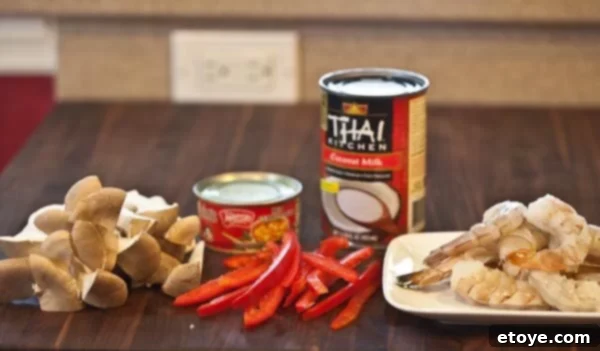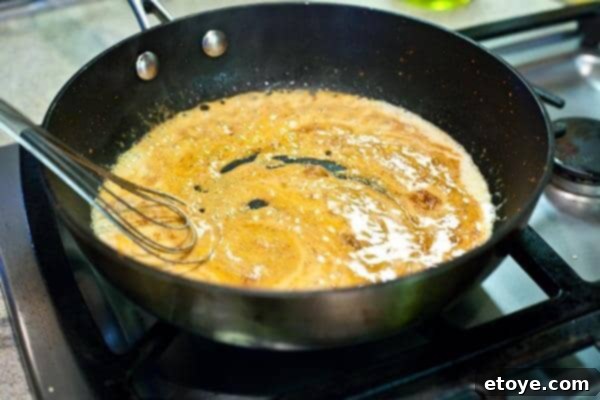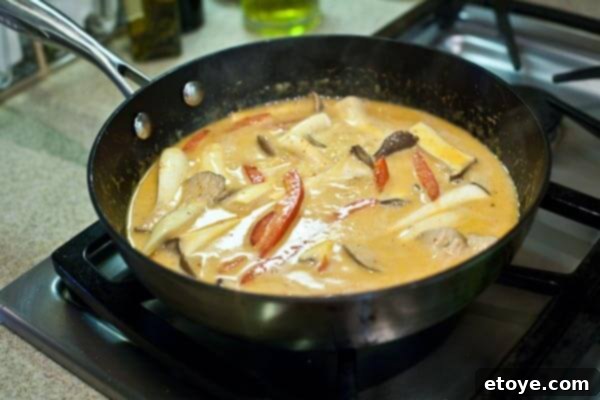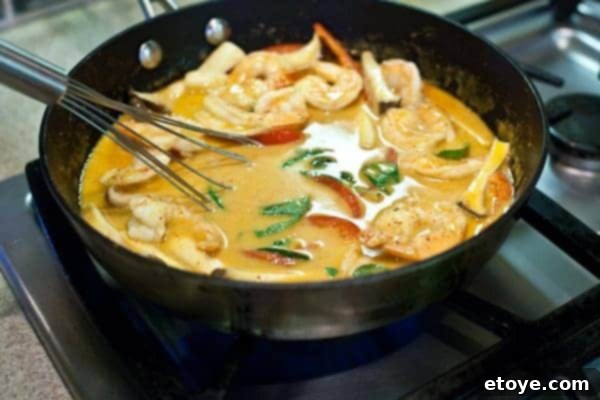
In the vast culinary landscape, even the most adventurous home cooks encounter their share of kitchen mishaps. We’ve all been there: a dish that was supposed to be a triumph turns into a charcoal blob, or an experimental recipe goes wildly awry. In moments like these, when culinary ambitions falter and hunger calls, it’s reassuring to have a reliable, flavorful dish to fall back on. For many, a vibrant Thai curry serves this exact purpose, offering both comfort and an explosion of taste with minimal fuss. It’s the ultimate culinary safety net, guaranteeing a satisfying meal even after the most challenging kitchen adventures.

My personal “break in case of emergency” meal is always a rich and aromatic Thai Shrimp Curry. It’s not just delicious; it’s incredibly convenient. My freezer and pantry are perpetually stocked with the core ingredients: a creamy can of coconut milk, a potent jar of curry paste, succulent shrimp patiently waiting in the freezer, and an assortment of fresh vegetables from the refrigerator. With these staples on hand, a gourmet-quality meal is never more than minutes away. Plus, perfectly cooked rice is either readily available with the push of a single button or already prepared and stored in the freezer, making this a truly effortless option for any busy weeknight.

Unpacking the Essentials: Key Ingredients for a Perfect Thai Shrimp Curry
The beauty of Thai Shrimp Curry lies in its simplicity and the ability to adapt it to whatever fresh ingredients you have on hand. However, a few core components are essential for achieving that authentic, irresistible flavor profile. Let’s delve into the star players that make this dish so special.
The Heart of the Flavor: Thai Curry Paste
Thai curry paste is the backbone of this dish, providing its distinctive aroma and spicy kick. Available in various forms—from convenient cans and plastic tubs to small sachet packets—choosing the right one is crucial. While red curry paste is a popular choice for its balanced heat and vibrant color, you might also explore green or yellow curry pastes for different flavor experiences. If you opt for a larger tub, remember that unused portions can be stored in the refrigerator for several months, making it a cost-effective choice. However, smaller cans often offer fresher, more intense flavor. Don’t be shy about adjusting the amount you use; a little goes a long way, but you can always add more to reach your preferred spice level.
Creamy Richness: Choosing the Best Coconut Milk
Coconut milk is what gives Thai curry its luxurious, creamy texture and subtly sweet undertones. When browsing the Asian aisle of your local supermarket, you’ll likely encounter numerous brands. A useful trick for selecting quality coconut milk is to gently shake the cans. Those that sound watery are often thinner and less flavorful. Instead, opt for cans that feel full of thick, dense liquid. This indicates a higher fat content, which translates to a richer, more satisfying curry. Be sure to choose full-fat coconut milk for the best results, as “light” versions often contain more water and less of that desirable creaminess. And remember, this is not the clear, watery “coco-loco” typically used in cocktails!
Succulent Protein: Shrimp and Other Alternatives
Shrimp is a fantastic protein for Thai curry due to its quick cooking time and ability to absorb flavors beautifully. Whether you prefer them tail-on for an elegant presentation or tail-off for easier eating, the choice is entirely yours. For convenience, frozen shrimp works perfectly and is often what I keep on hand. Just make sure to thaw them properly before cooking. If shrimp isn’t your preference, this recipe is incredibly versatile. Feel free to substitute with diced chicken, firm tofu, scallops, or even white fish fillets for a different take on this classic dish. Always adjust cooking times accordingly to ensure your chosen protein is perfectly cooked.
Earthy Depth: The Role of Mushrooms and Other Vegetables
Fresh vegetables add texture, color, and essential nutrients to your curry. I particularly love the meaty bite of large King Trumpet mushrooms. Their substantial texture holds up wonderfully in the sauce. If King Trumpet mushrooms aren’t available, fresh shiitake mushrooms offer a similar umami depth, or even regular white button mushrooms will work well. Beyond mushrooms, bell peppers (especially red for a pop of color and sweetness) and fresh basil leaves are standard additions. Thai basil provides a distinctive anise-like flavor, but regular sweet basil is a perfectly acceptable and delicious substitute. Don’t hesitate to experiment with other vegetables like bamboo shoots, snow peas, broccoli florets, or thinly sliced carrots to customize your curry to your liking.
The Perfect Accompaniment: Steamed Rice
A fragrant bowl of steamed rice is the quintessential companion to Thai curry, soaking up all the delicious sauce. Whether you’re a seasoned rice cooker user or prefer the stovetop method for perfectly cooked coconut rice, having it ready makes the curry come together even faster. For ultimate convenience, I often cook extra rice and portion it into freezer-safe containers. This way, a quick thaw and reheat are all that’s needed to complete your meal. Long-grain jasmine rice is typically preferred for Thai dishes due to its aromatic qualities and fluffy texture.
Step-by-Step Guide: Crafting Your Delicious Thai Shrimp Curry
Creating an authentic and flavorful Thai Shrimp Curry is simpler than you might think. Follow these steps for a perfect dish every time, building layers of flavor with ease.

Step 1: Awakening the Aromas – Blooming the Curry Paste
The first crucial step in any good curry is to bloom the curry paste. Heat a skillet or a deep pot over medium-high heat. Once hot, add a teaspoon of cooking oil (such as coconut or vegetable oil) and then stir in the red curry paste. Whisk it continuously for about 30 seconds to a minute. This brief sautéing helps to release the aromatic oils and deepens the flavors of the spices, preventing a raw, pasty taste in your final dish. The kitchen will instantly fill with a wonderful fragrance, signaling that you’re on the right track.



Step 2: Building the Base – Whisking in Coconut Milk
Once the curry paste is fragrant, it’s time to create the luscious base of your curry. Carefully pour in the coconut milk, then immediately whisk it thoroughly to incorporate the curry paste. This whisking action helps break down any lumps of paste, ensuring a smooth, evenly flavored sauce. Continue whisking until the mixture is fully combined and begins to simmer gently. This step is vital for achieving that creamy, cohesive texture that defines a great Thai curry.

Step 3: Adding Texture and Freshness – Cooking the Vegetables
With your curry base simmering, add the fresh vegetables. Start with ingredients that take a little longer to cook or those you want to maintain a slight bite, such as mushrooms and bell peppers. Cook them for about 2-3 minutes, allowing them to soften slightly while still retaining some crispness. At this stage, it’s a good idea to taste the curry. If you prefer a spicier dish, now is the perfect time to whisk in an additional teaspoon or two of curry paste until you reach your desired heat level. Remember, you can always add more, but you can’t take it away!

Step 4: The Star of the Dish – Perfecting the Shrimp
Next, introduce the shrimp to the simmering curry. Shrimp cooks very quickly, so be mindful not to overcook them, as they can become tough and rubbery. Cook for approximately 2-3 minutes, or until the shrimp turn opaque pink and are just cooked through. Their natural sweetness will complement the spicy, creamy sauce beautifully, adding a wonderful seafood element to the dish.

Step 5: Aromatic Finish – Stirring in Fresh Basil
Finally, remove the curry from the heat and stir in the fresh basil leaves. The residual heat from the curry will gently wilt the basil, releasing its fragrant aroma and adding a fresh, herbaceous note that brightens the entire dish. A quick stir, and your magnificent Thai Shrimp Curry is ready to be savored.

Serve this exquisite Thai Shrimp Curry piping hot over a generous bed of fluffy, cooked rice. The combination of spicy, sweet, and savory flavors, along with the creamy texture of the coconut milk and the tender shrimp, makes for an unforgettable meal that’s surprisingly easy to achieve.
Pro Tips for Your Best Thai Shrimp Curry
Elevate your Thai Shrimp Curry experience with these extra tips and tricks, ensuring every batch is as perfect as the last.
- Spice Level Customization: If you’re sensitive to heat, start with less curry paste and taste test as you go. For extra spice, consider adding a pinch of red pepper flakes or a dash of sriracha at the end.
- Ingredient Substitutions: Don’t limit yourself to shrimp and mushrooms. This curry is incredibly forgiving! Try adding cubed chicken, firm tofu, scallops, or other quick-cooking vegetables like snap peas, bamboo shoots, or baby corn.
- Make it Vegetarian/Vegan: For a plant-based version, simply omit the shrimp and use tofu or tempeh as your protein. Ensure your curry paste is vegan-friendly (some contain shrimp paste). Load up on extra vegetables like spinach, broccoli, or sweet potatoes.
- Enhance the Flavor: A squeeze of fresh lime juice just before serving can brighten all the flavors. A pinch of brown sugar can balance the heat and acidity, adding a more authentic Thai taste.
- Meal Prep Friendly: Thai curry makes excellent leftovers. Prepare a larger batch and store it in airtight containers in the refrigerator for up to 3-4 days. It also freezes well, making it perfect for future emergency meals.
- Serving Variations: While rice is traditional, consider serving your curry over quinoa, rice noodles, or even with a side of naan bread for dipping.
Thai Shrimp Curry
The amount of curry paste you use is totally up to you. I’ve used 2 tablespoons, which is about medium spice level. You can always add more curry paste after tasting, so it’s best to start with a little bit and work your way up. If you’re cooking rice, make extra and freeze for next time.
Ingredients
- 1 teaspoon cooking oil
- 2 tablespoons red curry paste (or more, to taste)
- 12 ounces coconut milk
- 1 red bell pepper, seeded and cut into strips
- 8 ounces fresh mushrooms (I used King Trumpet mushrooms)
- 1 pound shrimp, peeled and deveined
- 16 basil leaves (optional, but highly recommended)
- Cooked rice, for serving
Instructions
- Heat a skillet over medium-high heat. Once hot, add the cooking oil and red curry paste. Whisk constantly for about 30 seconds to release the aromas.
- Pour in the coconut milk and whisk thoroughly to combine with the curry paste. Bring the mixture to a gentle simmer.
- Add the mushrooms and red bell peppers to the simmering curry. Continue cooking for about 3 minutes, or until the vegetables begin to soften. Taste the curry at this point and whisk in additional curry paste if you desire more spice.
- Add the shrimp to the curry and cook for another 2-3 minutes, or until the shrimp turn opaque pink and are fully cooked through.
- Stir in the fresh basil leaves just before serving. The residual heat will wilt them. Serve immediately over hot cooked rice.
Notes
I used King Trumpet mushrooms for their meaty texture.
Find the perfect steamed rice recipe here.
Tried this recipe?
Let us know how it was!
